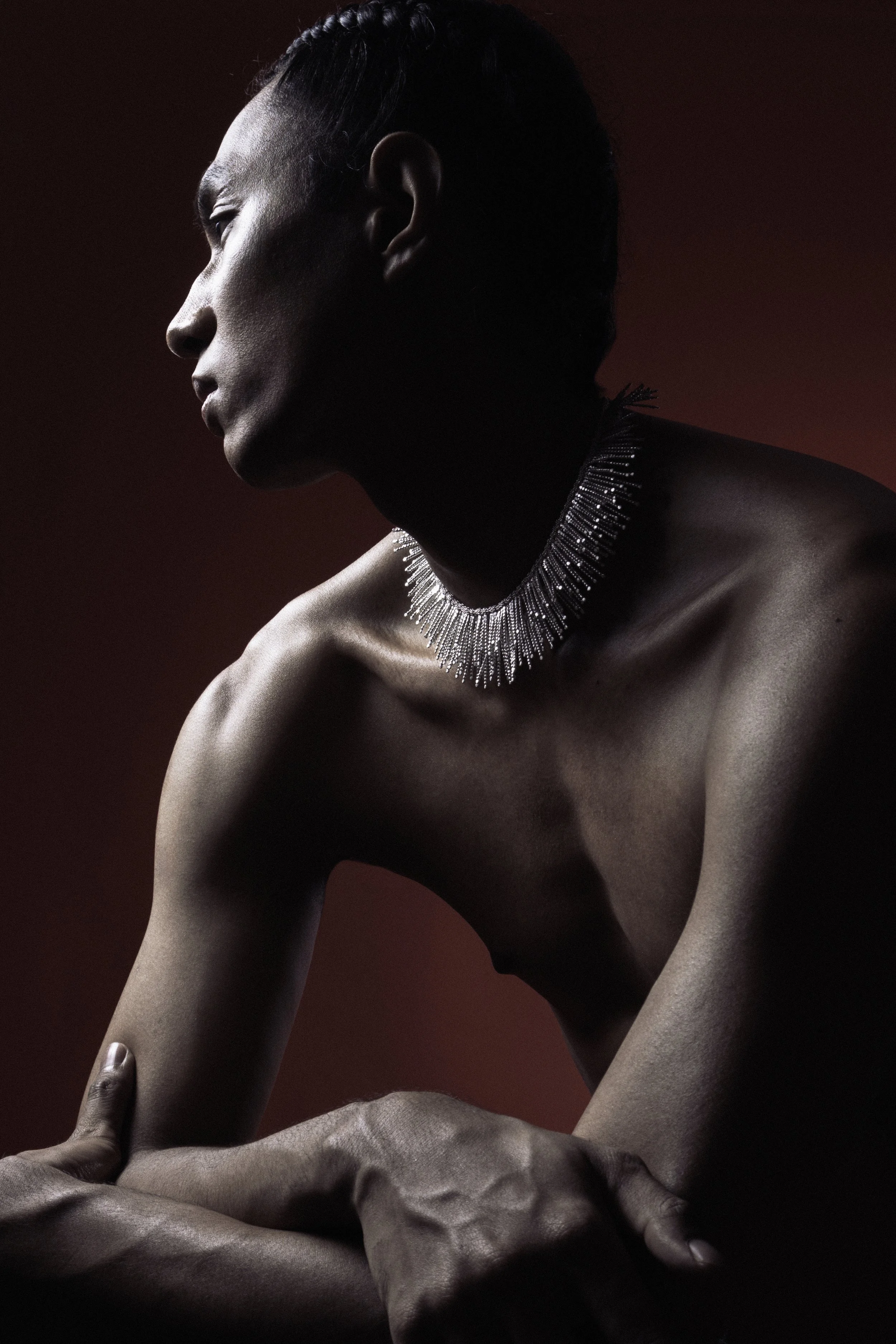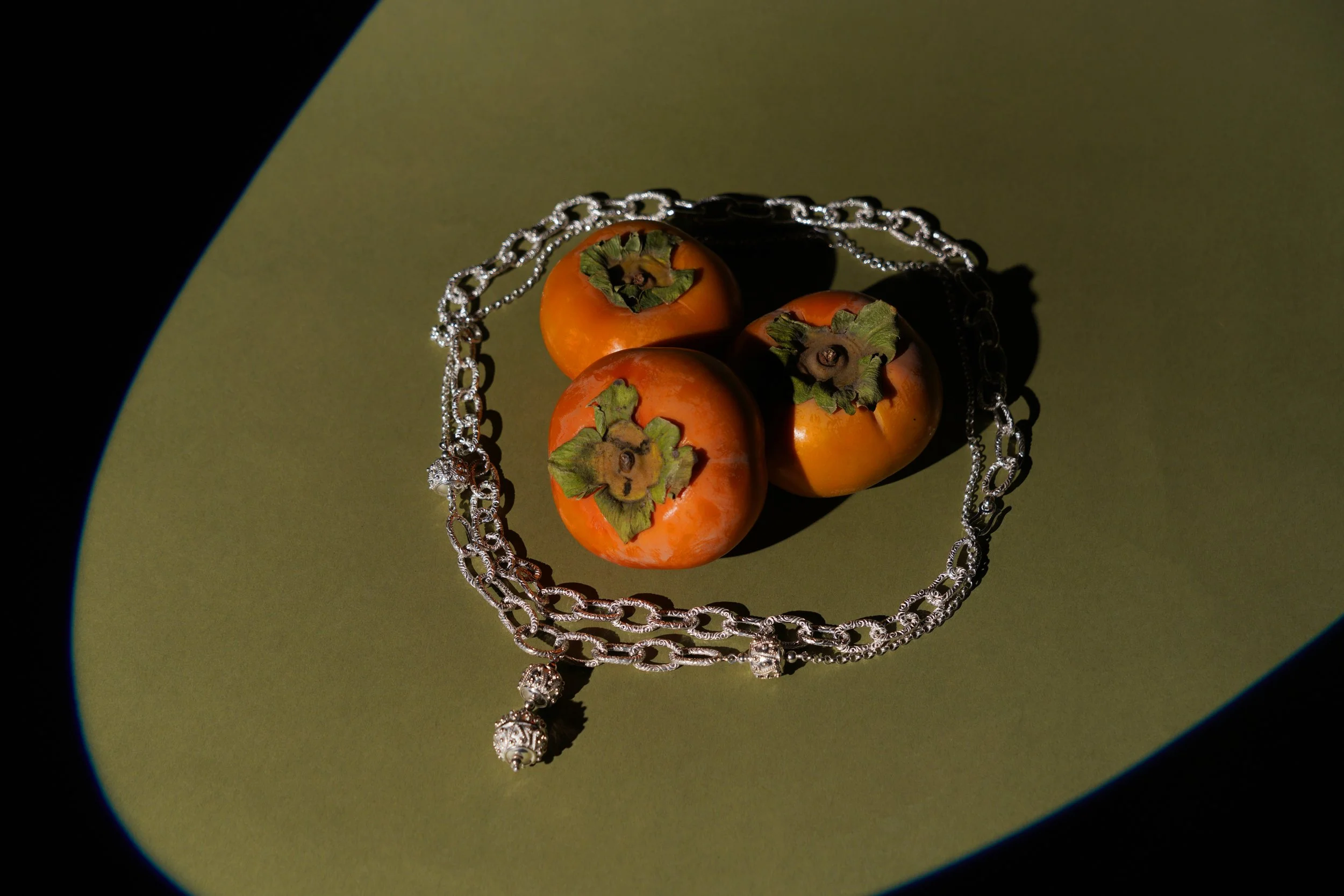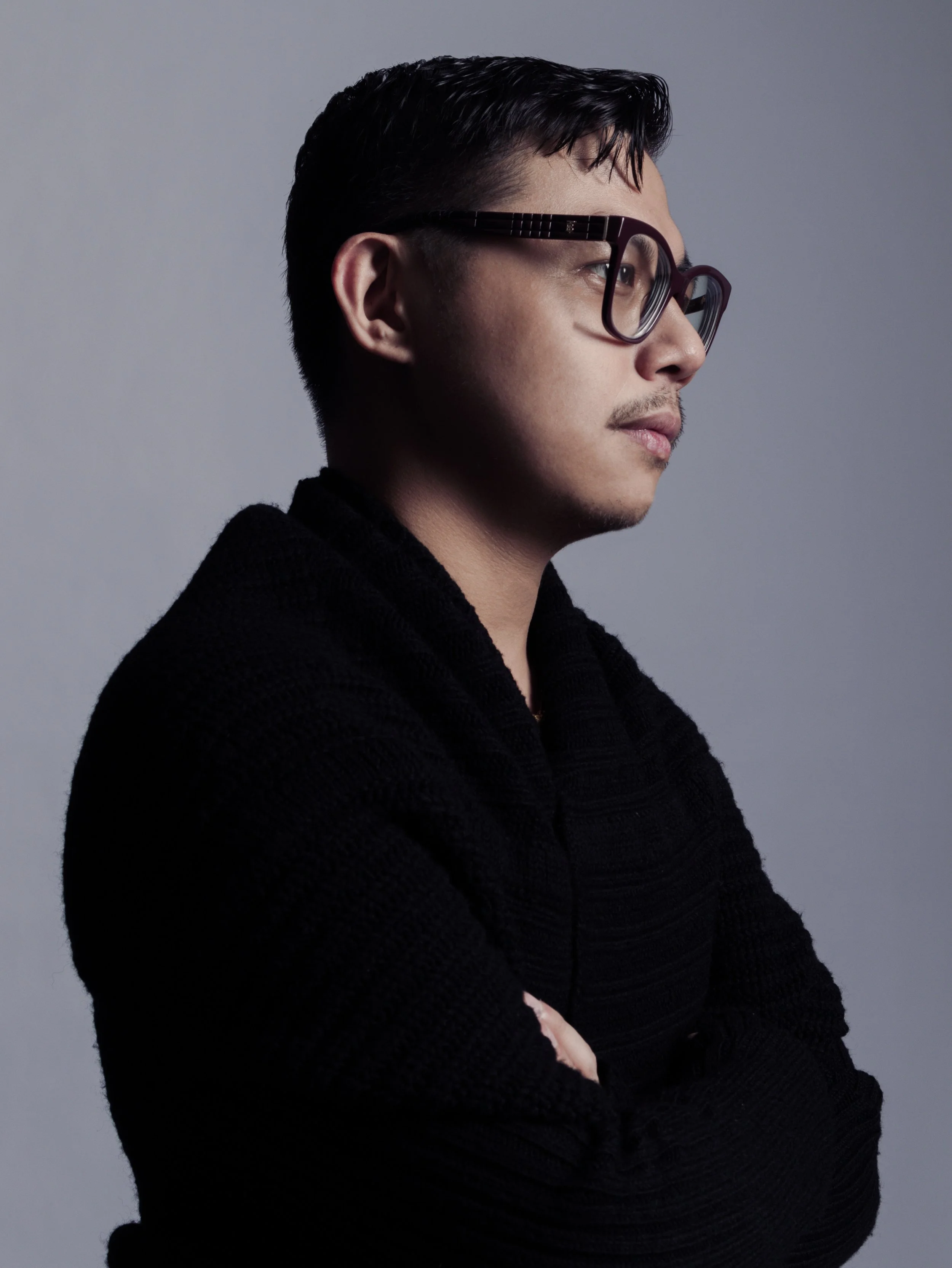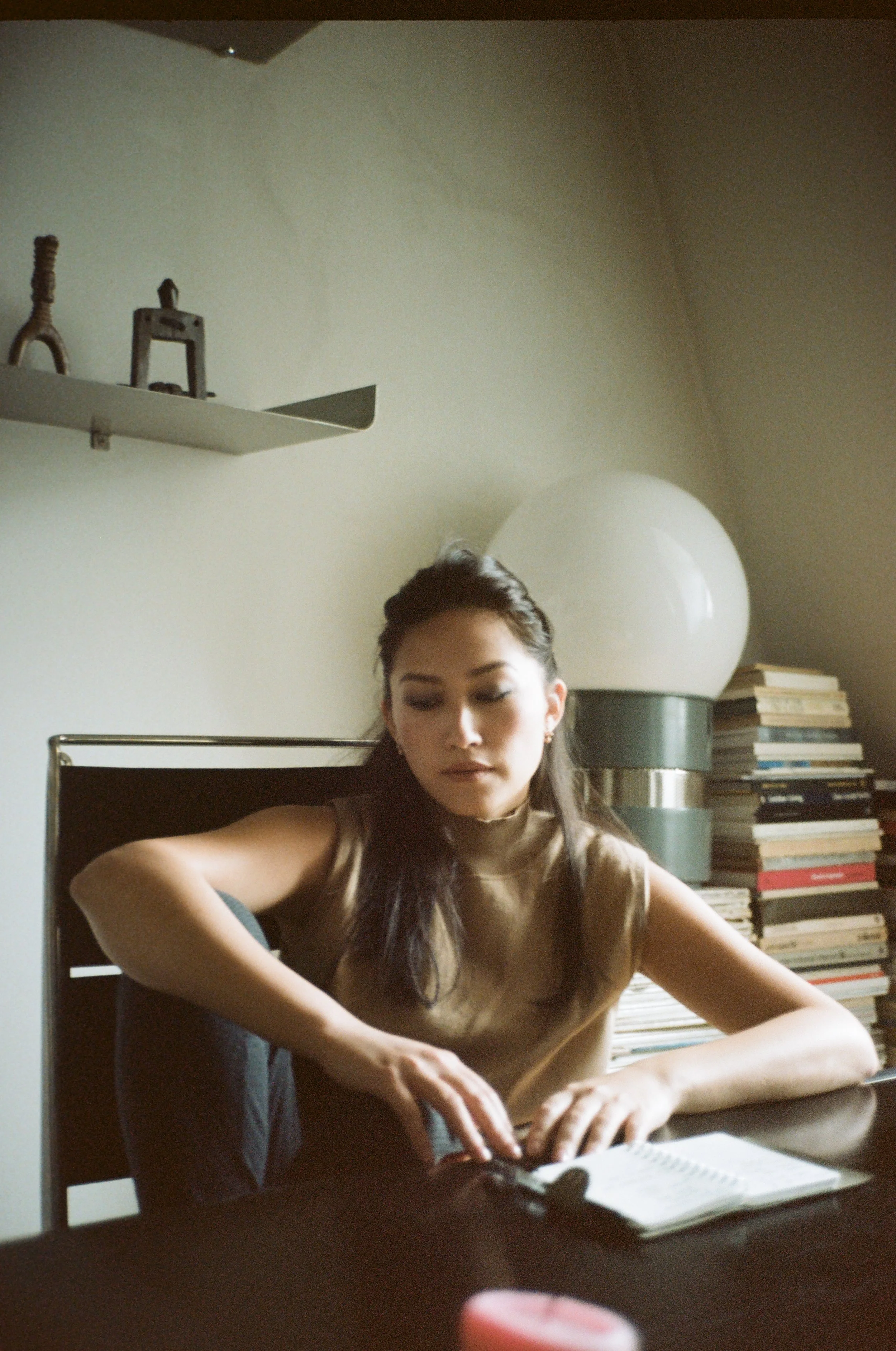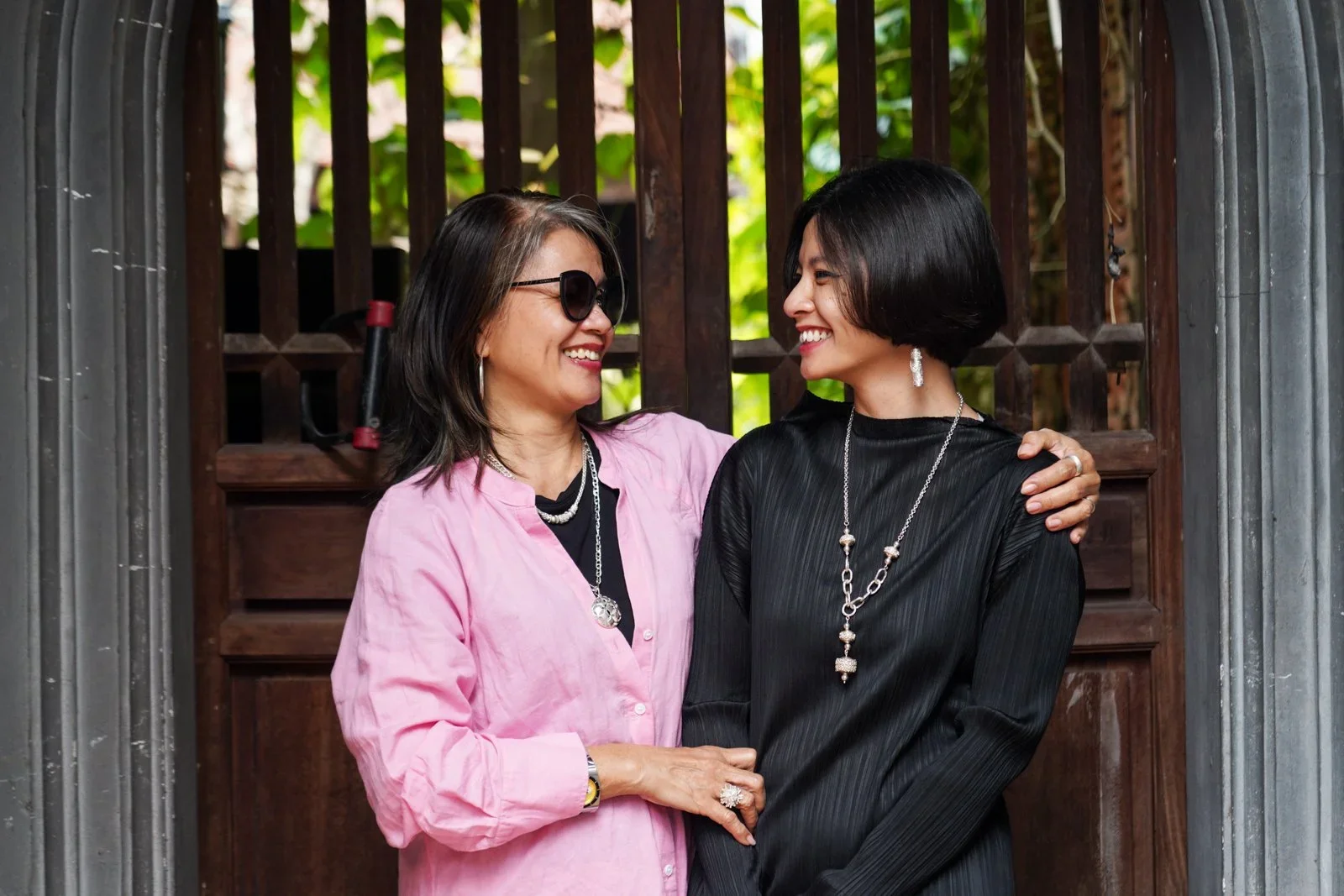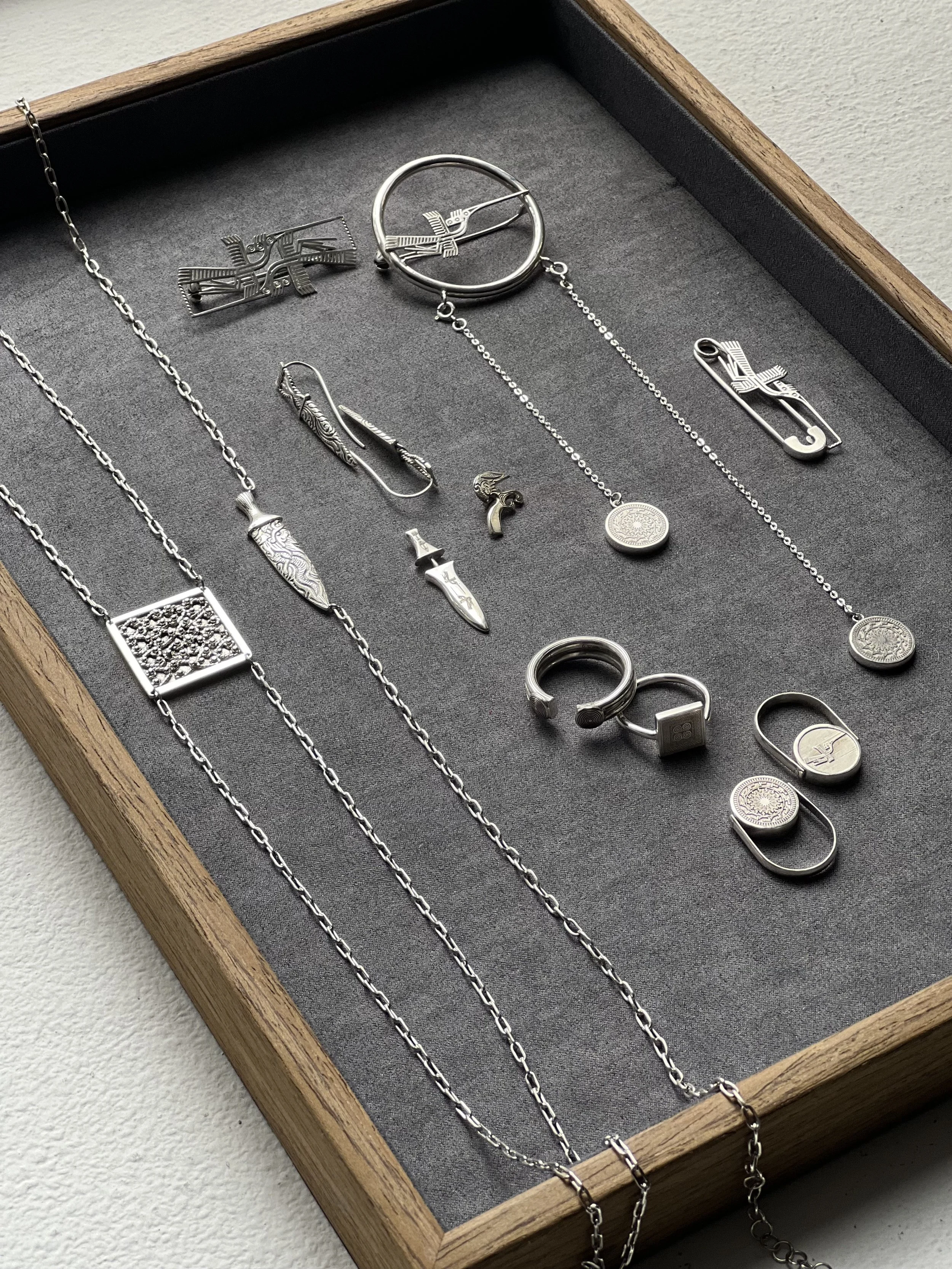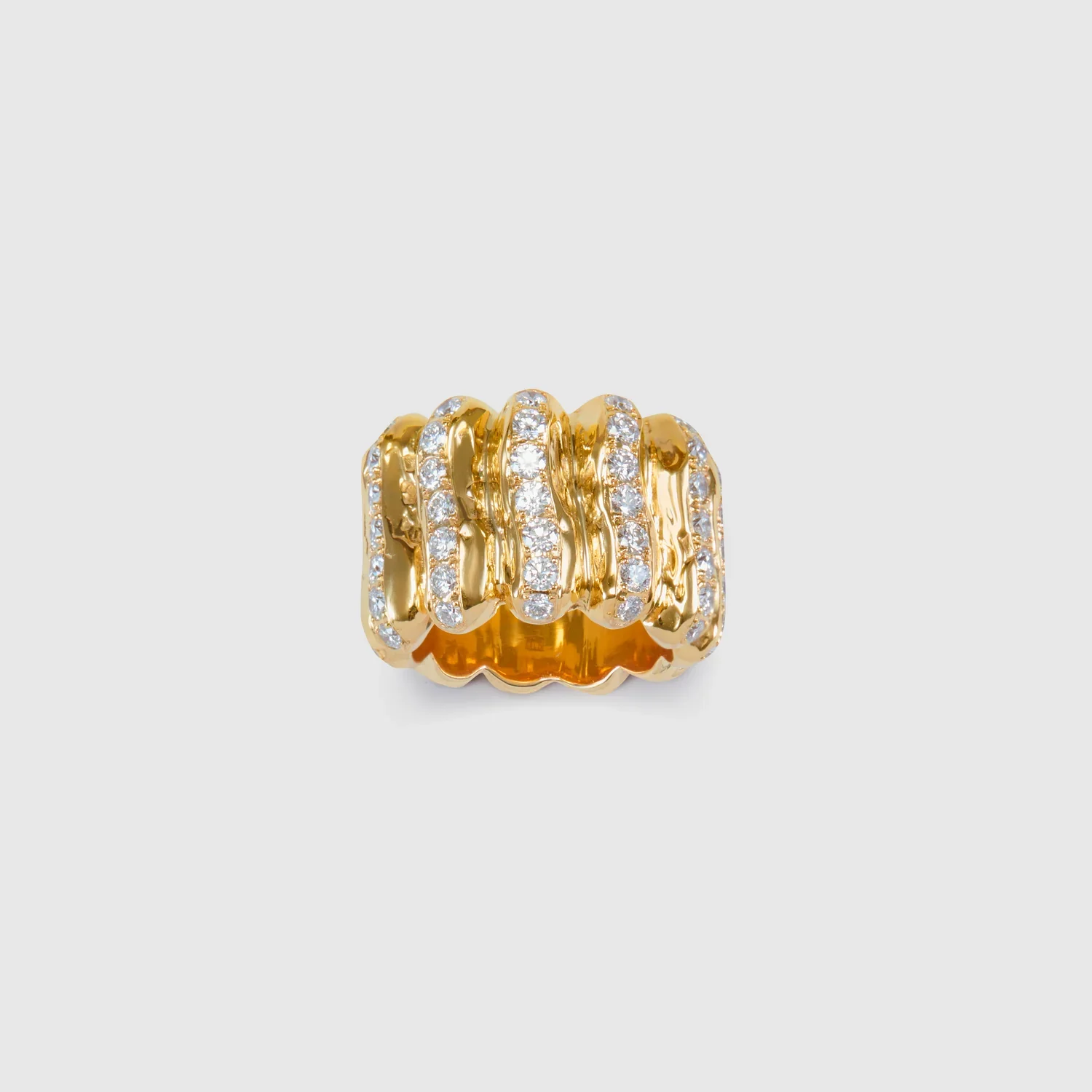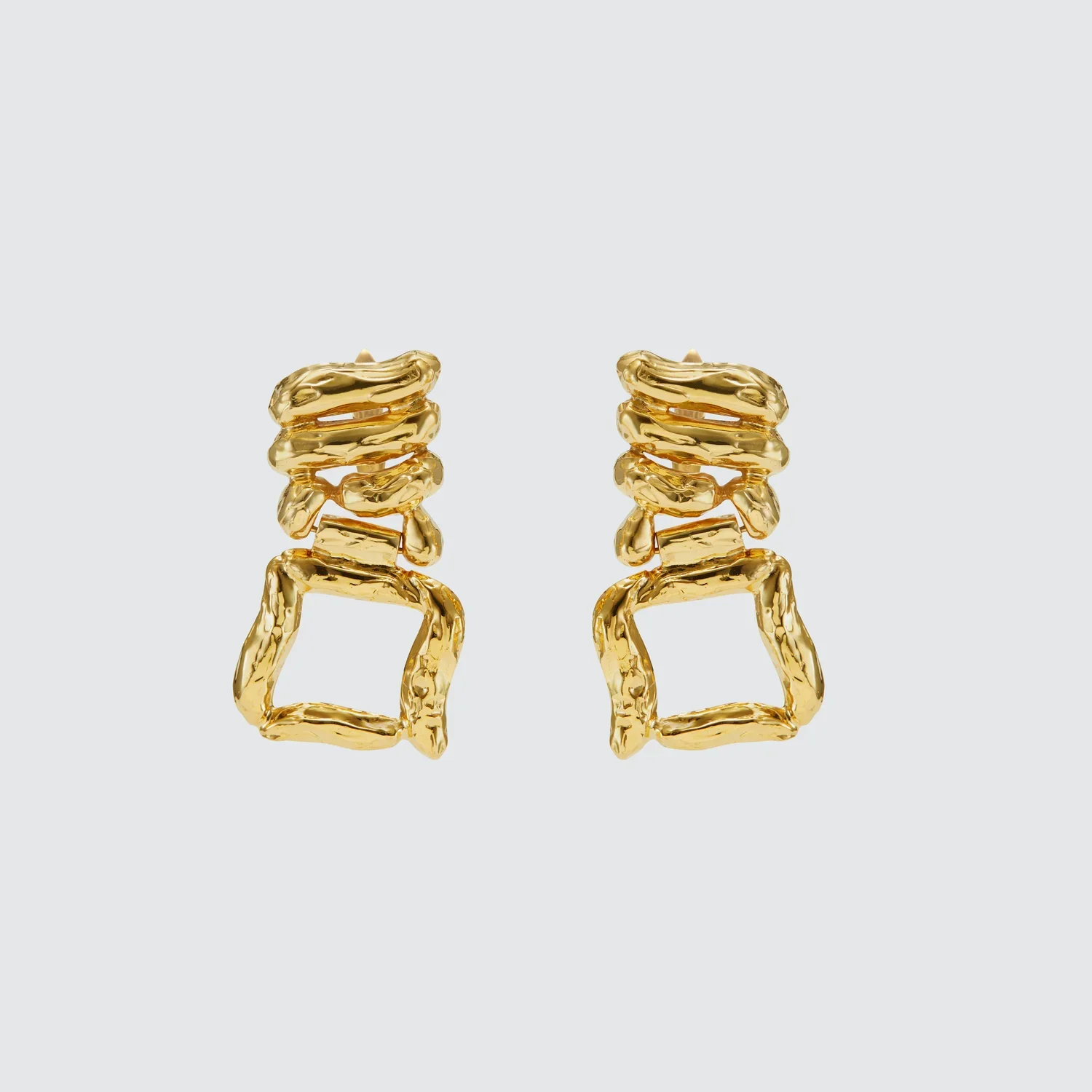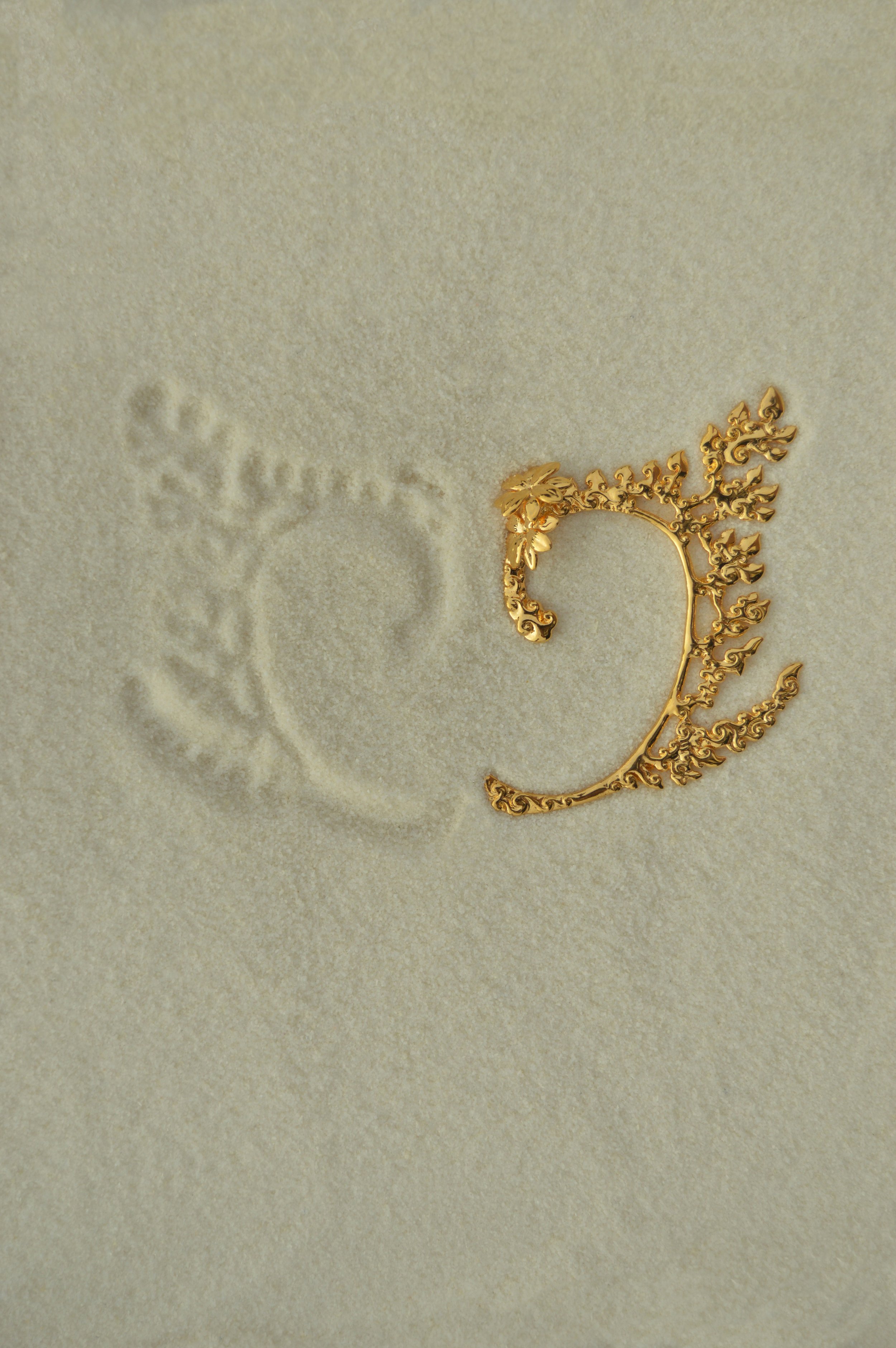From Fragments to Futures: Reclaiming Culture in Southeast Asian Jewellery
Inside Adam Pereyra, Patcharavipa, BAC and EdoEyen
Adam Pereyra’s Arawari Choker, which features 186 individual beads, each containing approximately 34 spherules and totaling over 1,800 hand-forged parts. Photo by Felix Cari. Image courtesy of Adam Pereyra.
In Southeast Asia, jewellery has functioned as a form of inheritance, reifying stories of land and labour as much as it signals kinship or wealth. From burial ornaments to court regalia, these objects carry both material heft and symbolic freight across generations. Within contemporary design practice, however, such historical objects become charged points of reference. In this essay, we speak to four designers—Adam Pereyra, Patcharavipa, EdoEyen, and BAC —who merge deep historical knowledge and ancestral techniques with their own contemporary craft explorations.
We spoke to them about their latest collections and the ideas that sustain their practices. Each designer reflected on how their heritage continues to animate their work, revealing a patchwork of visions with a shared commitment to treating jewellery as a medium where history, identity, and experimentation combine to produce lustrous new forms.
BẠC’s MAY Chunky Chain Necklace featuring a depiction of the Vietnamese Dragon carved by hand on each link. Image courtesy of BẠC.
For these designers, creative authority begins with personal lore: a grandmother's necklace, a family ritual of silversmithing, childhood fascination with dance regalia. Yet personal memory expands into collective inheritance. Each piece holds both intimate sentiment and communal knowledge, linking individual stories to craft traditions that span generations.
Adam Pereyra. Portrait by Felix Cari.
For Adam Pereyra, an early awakening to gold through his grandmother has developed into a systematic study of ancestral motifs embedded in Philippine artisanship. “Early on, I was captivated by shapes, textures, and objects that told quiet stories,” he reminisces. From childhood, I collected small things—glass, metal, stones—and imagined the worlds they came from. The brand is simply a continuation of that impulse, refined through design and technique.” Like a magpie, his process sieves fragments of history and fashions them into compositions that shimmer with both old wisdom and new possibility. He elaborates, “Ancient forms are studied, broken down, and reinterpreted through new fabrication and unusual material pairings so they stay rooted and forward-looking.” Through this approach, centuries-old Philippine artisanal methods are given renewed expression in creations that feel both inevitable and surprising.
Patcharavipa Bodiratnangkura.
For London-based Patcharavipa Bodiratnangkura, her practice is an evolving conversation between Thai roots and Japanese philosophy. She recalls, “From an early age, jewellery became a form of storytelling for me—whether it was embellishing everyday objects with crystals or re-imagining family heirlooms. Raised within a lineage of Thai innovators, I inherited both a respect for tradition and a desire to re-invent it.” That tension continues to shape her maison, founded in Bangkok in 2016 after her studies at Central Saint Martins and further training in gemology.
The brand’s debut collection, ‘Coexistence’, drew directly from Thailand’s material culture, utilising recycled coconut shells from violin-making in Amphawa, Burmese ebony, and Siam gold—now the maison’s signature. Inspired by the Japanese philosophy of wabi-sabi, she celebrates rather than conceals imperfection. “To me, jewellery is a sentimental piece that reflects longevity and heirloom quality,” she reflects. “Unlike other items such as clothes and shoes, jewellery is something that you can bequeath to the next generation. There is a value that will last.” This combination of organic process and precious materials produces pieces that fulfill her vision: jewellery with enough character to become meaningful heirlooms.
Mother and daughter, Liên Hoàng and Linh Nguyễn.
Like Patcharavipa, BẠC, founded by mother and daughter Liên Hoàng and Linh Nguyễn, treats jewellery-making as both intimate and historic, a way of carrying memory forward into the present. “It all began with a family heirloom silver necklace, designed and made by my mother. Wearing silver jewellery is a tradition of my family; it runs in the blood. My mom had been making and repurposing silver accessories for the whole family since I was very little,” Linh explains. In Vietnamese, bac refers to silver, a fitting name for a brand rooted in one of the country’s oldest crafts—traditional Vietnamese silversmithing dates back to the 18th century, often practiced within small families and passed down through generations. BẠC’s mission involves keeping these techniques alive and visible.
Sisters Edo and Eyen Chorm.
Similarly, EdoEyen grounds its practice in familial recollection. Founded in New York by Cambodian-American sisters Edo and Eyen Chorm, the brand reinterprets the ornate regalia of the Royal Cambodian Ballet and the splendour of Angkorian court jewellery into bicultural treasures. “Everything we learnt, everything we drew inspiration from came from my mum,” Edo explains. Their mother had been a classical dancer in the Royal Cambodian Ballet, performing in the ornate regalia that would later inform the sisters’ earliest ideas of jewellery. When the Khmer Rouge forced her to leave Cambodia, she resettled in America and rebuilt her life.“We have a deep passion for pushing Khmer art and culture to the forefront of fashion. Representation matters to us, especially in a global playground like New York, yet Khmer culture has remained unseen here for decades. We want to change that.” For them, jewellery design is cultural reclamation, making Khmer artistry impossible to overlook.
Adam Pereyra’s silver barter rings. Image courtesy of Adam Pereyra.
BẠC’s VIỆT-NAM Rotating Ring, ‘CỘI’ Collection. Image taken from BẠC’s website.
These four designers reveal how intimate knowledge of history and traditional techniques enables their most radical reconfigurations. From Milan's runways to intimate ateliers, their experimentations span archaeological reconstruction and historical translation, organic accumulation and modernist reduction.
Adam’s most recent collection, for instance, fragments and reassembles pre-colonial techniques with unexpected material hybrids. Taking this exploration to Milan Fashion Week SS 2026, and first presented at the PHx Fashion Group and Comme Ci showcase, he binds silver, with its weight and association with pre-colonial metallurgy, into the pliancy and porosity of fibre. "I wanted to see how metal and thread could coexist,” he explains. “Silver forms the body, while newly developed Philippine fibers weave through and around it, bringing opposites into one frame.”
BẠC’s ‘CỘI’ Collection. Image courtesy of BẠC.
BẠC, too, finds its anchor in silver, though its focus is on historical symbolism, translating Bronze Age motifs into spirited silver pieces that range from earrings to brooches. Their recent mini-drop, ‘CỘI’—from Cội Nguồn, “The Origin” in Vietnamese—returns to the Bronze Age Đông Sơn culture. “‘CỘI’ encapsulates the essence of origins and foundations. It symbolizes the roots from which we grow, honoring our ancestors, values, and the cultural education that shapes us,” the founders explain. The collection draws on the famed Đông Sơn bronze drums, the mythic Lạc bird, Vietnam’s national bird, associated with dreams, and bronze shields and daggers once used as both ritual objects and protection.
Patcharavipa’s Savory Ring, ‘Blur/Mirage’ collection. Image taken from Patcharavipa’s website.
Patcharavipa’s Biscuit Cutter Earrings, ‘Blur/Mirage’ collection. Image taken from Patcharavipa’s website.
If silver grounds their explorations, Patcharavipa and EdoEyen turn mainly to gold as their expressive medium—the former into intimate, sensual forms, the latter into statements at once seductive and defiant. Patcharavipa's ‘Blur/Mirage’ collection pursues maximum fluidity through process-led aesthetics. "My latest collection is a meditation on distortion, perception, and sensual form," she explains. It transforms Siam gold into voluptuous, undulating forms that mirror the indulgent curves of patisserie from the Lisboa cafés in London and Parisian boulangeries. Rings twist like folded dough while earrings cascade in layered spirals; the gold maintains a fluid quality that recalls pastry under heat.
EdoEyen’s Roumdul Earrings and Phkamaliah Necklace. Image courtesy of EdoEyen.
Patcharavipa, Spring/Summer 22 ‘Lignes d’Été’ collection. Photo by Marton Perlaki. Image taken from Patcharavipa’s website.
While Patcharavipa builds through organic accumulation, EdoEyen strips down through modernist reduction. EdoEyen's ‘Body’ collection distills Angkorian court jewellery down to essential architecture. “One of the newest design directions is centered around form without excess. It strips away surface carvings to let bold silhouettes and clean lines speak for themselves,” they explain. Crafted from conflict-free, recycled gold in New York's Diamond District, their Phkamaliah Necklace, Macha Arm Cuff, and pectoral pieces recall ancient regalia through minimalist geometry rather than decorative detail. Through this reductive approach, EdoEyen demonstrates how subtraction can amplify cultural resonance as effectively as addition.
EdoEyen’s Neang Neak Ear Cuff. Image courtesy of EdoEyen.
Adam Pereyra’s brand campaign featuring handwoven 18K solid gold pieces. Photo by Felix Cari. Image courtesy of Adam Pereyra.
While unique in their philosophies, these four approaches share crucial infrastructure: each brand deliberately sustains artisan networks. Pereyra collaborates with Filipino master goldsmiths, Patcharavipa maintains an atelier of Bangkok craftspeople, BẠC works with Vietnamese silversmiths, and EdoEyen partners with New York's Diamond District specialists. "Southeast Asian jewellery is a system of knowledge tied to trade, ritual, power, and storytelling," Adam reflects. "These practices show that our region's design language is sophisticated and relevant, and when placed on the global stage, it holds its own." The Chorm sisters reinforce this point, "The true originality comes from the smaller, often overlooked artisans. We want to celebrate them, because we know their genius is raw and foundational." Through these collaborations, ancestral knowledge becomes stretched, tested, and reformed to accommodate both conceptual ambition and technical experiment. They embody an approach that honours centuries of wisdom and boldly speculates on its future forms.

